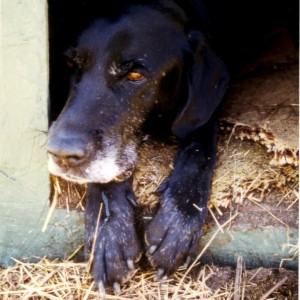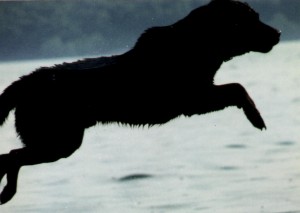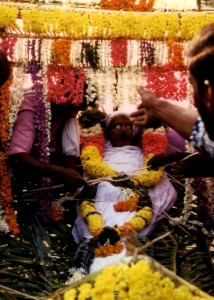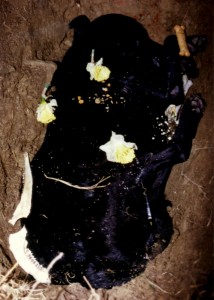How My Dog Taught Me the Power of Ritual


Our ten-year-old Lab left the car reluctantly. Instead of running ahead and waiting on the dock for us to throw a stick, our water boy stood near the car door without a wag.
“He has cancer,” the vet said a few days later. Leo wasn’t in pain, so we took him home, hoping for a few good weeks.
Ten years earlier, we chose the biggest male in a litter of Labs, the pup with scratches all over his round pink belly from climbing over the fence. Leo was a swimmer and diver, a fetcher and explorer, a woodchuck destroyer and a family guardian.
 A month after the vet visit, Leo stopped eating. One morning, he circumambulated the house, down around the barn and out to the garden, around to the front porch and then to his doghouse near the back porch. He stopped to rest a hundred times, but he stayed focused on his journey.
A month after the vet visit, Leo stopped eating. One morning, he circumambulated the house, down around the barn and out to the garden, around to the front porch and then to his doghouse near the back porch. He stopped to rest a hundred times, but he stayed focused on his journey.
“Hey, Leo. You feeling bad, boy?” I said when he returned to his dog house. His tail wagged half-heartedly, but his eyes were dull. I cooked him scrambled eggs, but he turned his face away.
“We have to take him to the vet tomorrow,” I said. “He’s suffering now.”
“I know,” Vic said.
We coaxed Leo inside the house. Friends dropped by to say goodbye. Late in the afternoon, Leo tried to get up and fell back. I couldn’t find a pulse. He was gone, just like that.
 Vic and I had visited India three times. Funerals were part of life on the streets there. With the family’s permission, Vic had photographed a flower-covered cart standing outside a tiny earthen house. A dead man lay in the cart with coins over his eyes.
Vic and I had visited India three times. Funerals were part of life on the streets there. With the family’s permission, Vic had photographed a flower-covered cart standing outside a tiny earthen house. A dead man lay in the cart with coins over his eyes.
“We’ll give him his last journey,” the man’s brother told us, smiling and wiping away tears while he fussed with the flowers. A small parade of people gathered to accompany the man to the cremation ground.
Vic and I rolled Leo in a blanket and left him in the house while we dug a deep hole near the garden. The soil was black and loose.
 “Let’s take Leo for a last ride,” Vic said. “Like India. I’ll get the wheelbarrow.”
“Let’s take Leo for a last ride,” Vic said. “Like India. I’ll get the wheelbarrow.”
I picked daffodils and gathered bones, dog biscuits, and dog toys. We lifted Leo into the wheelbarrow. While I walked alongside like the grieving family members in India, Vic pushed Leo to his favorite spots—the dog house, the back porch, the front porch, the compost heap, until the journey ended at the deep hole near the garden. We tucked Leo in with bones and flowers. The earth would be his blanket.
 “You’re a good boy, Leo,” we said. “You’re the best dog ever.”
“You’re a good boy, Leo,” we said. “You’re the best dog ever.”
Quietly and solemnly, we shoveled rich loam over his body and smoothed the earth. As we worked, we paused and told our favorite stories about the woodchuck devourer and wild Seneca Lake diver, the sweet snuggler and avid eater. We wept, added more flowers and soil, and kept talking to Leo.
That day, I learned how to comfort myself with simple personal rituals.
***
Leo taught us the power of a homemade ritual to soothe and comfort grief. I’m grateful to Michelle DeHaven Nichols, non-profit founder and Executive Director of AHELP Project whose mission is to promote hospice philosophy as a paradigm shift in care for animals in age, chronic and terminal illness. Visit the website if you’re a pet lover. Michelle’s interest in ritual and grief reminded me of Leo and his end-of-life ritual. I’d love to hear about your experiences with helping your pets die. For other stories about family dogs, see Goodbye, My Miss Daisy. For other articles about ritual, see Creating a Grief Ritual. If you’d like to know more about creating personal ritual, you’ll enjoy my TEDx talk.



January 16, 2015 at 1:34 pm
Kim Kluxen Meredith
My late husband David insisted that we get a dog when the children were young. He also named him. I was only familiar with barn cats so I dragged my feet. Harry Tanqueray turned out to be a great pet and my buddy for 17 years. He slept with me after David died and kept me company when the kids went to college. When it came time to say goodbye I lured our Cairin terrier into the car with a bisquit. I felt like I was betraying him but he was sick and I did not want him to suffer any more. When I exited the vet’s office with his collar and tags I cried. There was one more step for closure. I went to a local bar and had 2 Tanqueray martinis. One for Harry and one for David.
January 17, 2015 at 8:22 am
Elaine Mansfield
Oh, Kim. I see the scene and you in it with your empty dog collar, Tanqueray martini, and tears. I love your example of a personal ritual created to soothe you and honor what you’ve lost. You had everyday symbols meaningful for you, spontaneity, sorrow and love, and even a touch of whimsy. Here’s to you, Harry. Thanks for sleeping with Kim when she most needed an understanding friend. Thanks for sharing your sweet satisfying ritual.
January 16, 2015 at 9:55 am
Marty Tousley (@GriefHealing)
Beautiful as always, dear Elaine. You could write another book just on the value of ritual as a healing tool in grief. Your ability to tell a story and make a point ~ complete with the perfect accompanying photographs ~ just amazes me. ♥
January 17, 2015 at 8:15 am
Elaine Mansfield
Thank you, Marty. I find myself talking about ritual and speaking about it more and more. It’s such a simple way to bring a little comfort. The first time I wrote about ritual in June 2012, I googled “ritual and grief” so I could link to other articles on the subject and found an article you’d written about Valentine’s Day ritual. I added a link to your article and contacted you. What a good day that was! Here’s a link to your article “Grief on Valentine’s Day”: http://www.selfhealingexpressions.com/grief_on_valentines_day.shtml
January 14, 2015 at 2:18 pm
Liz
I love the image of wheeling Leo around for a last ride. Beautiful story!
January 14, 2015 at 5:05 pm
Elaine Mansfield
Thanks, Liz. Leo was a great dog. I know you have a few great dog stories to tell.
I resurrected the legging you made for Willow a few years back. Iteeps her warm and keeps her from messing with the stitches.
January 14, 2015 at 10:30 am
D.G. Kaye
What a touching story Elaine, as off your stories are. Pets are children to all families, so why not give them a loving burial? <3
January 14, 2015 at 1:39 pm
Elaine Mansfield
Leo was a great dog. I’m hearing stories from others who remember him and his tricks. We all think our dogs are great. They’re ours and, as you say, they’re family. The burial was a ritual of comfort for Vic and me, so it was good practice for me for harder losses that came later.
I hope you’re at the unpacking stage.
Warmly, E
January 20, 2015 at 9:04 pm
D.G. Kaye
Bruised and broken, I am gratefully unpacked. 🙂
January 21, 2015 at 8:44 am
Elaine Mansfield
I hope your brokenness will mend quickly. Sorry it was so hard.
January 13, 2015 at 8:48 pm
Jill Swenson
This past summer I made the hard decision to let my two Dalmatian dogs go with the help and support of a local hospice and palliative care vet, Dr. Katherine Goldberg. One would not be able to live without the other. One couldn’t get up and down stairs for a tumor and the other’s kidneys were failing. When I saw the pain leave their bodies I knew letting them go was the right decision. Not easy, but made easier with a compassionate and caring system of support, including my dog-loving friends like you, Elaine.
January 14, 2015 at 9:55 am
Elaine Mansfield
I’ve made similar decisions quite a few times, Jill. It’s unsettling and difficult to weigh their suffering vs our desire to be with them and extend their life. A few years ago, my vet Vivien Surman came to my home to euthanize old Daisy who was suffering. It was wonderful that Leo checked out on his own before we had to call the vet. I agree it’s made easier by our friends who understand what we’re going through. Thank you for being one of those friends, Jill.
January 17, 2015 at 12:33 pm
Michelle Nichols
Elaine, What do you think of the concept of suffering as it is used so commonly in the death of our animal companions? How do you define it? I personally have found it to be so subjective, and don’t care for the negativity it conveys. How does one know truly what the being is experiencing? Have they lost the will to live?
I don’t care for the term and have banned it from use in our organization. All too often I believe that the very negative impression it leaves is that the loving caregiver has gone too far and waited too long to make difficult decisions. In fact, slowing, sleeping more, lack of energy, hunger and even the need for hydration exists naturally in the dying process. We point to the death of humans who can communicate their true feelings as they die in hospice-supported natural dying. Did your husband, for instance, lose the will to live or did he likely feel supported under your loving care and possibly, your vigil at the bedside? Did he want to cut short the time he had here with you in those moments? (my apologies, I haven’t been able to read your book yet.)
What I do encourage caregivers to do, and in fact I insist, is to monitor quality of life. When pain cannot be managed anymore, as evidenced by behavioral signs that aren’t often arguable, then it’s time to proceed with a plan for euthanasia. They have hard work to do to get in touch with their values, goals and beliefs for their animal companion’s care. Empowered by this awareness, they acknowledge when these events or signs occur and proceed with their plan for either euthanasia or else, they decide to allow their animal to die in it’s own time under their loving care. Ultimately, they feel they made the best decisions at the approprate times. Healing proceeds naturally and completely after this process, in our experience.
I want to be very clear that I’m not at all opposed to euthanasia! A plan for or against dying natually under hospice care depends upon whether or not it’s in the family’s plan for their companion’s farewell from this earth, AND whether good palliative care can be achieved for the animal and their family. We always keep euthanasia in the plan if hospice-supported natural death is being pursued.
I realize that animal hospice is a differnt construct than human hospice is, because of the proxy care decisions and euthanasia as society’s norm. What I’m conveying here is the emerging opinion in our field of animal end-of-life care. I’d love your thoughts!
January 17, 2015 at 2:35 pm
Elaine Mansfield
Hi Michelle,
I can only talk about my personal experience. I’ve been grateful when my dogs died naturally at home. I dislike being in the role of deciding whether or not a life is worth living. My thirteen-year-old Lab Daisy could not walk, even with a harness and human help. Her hind quarters had been gone for a while, but the front legs stopped working, too. She had lost bowel control more than a year before and that was obviously upsetting to her, but I dealt with it and reassured her. In the last month, she lost urinary control, too, and couldn’t get outside even with help. So she held her urine for hours until she couldn’t. Perhaps I projected suffering on her, but I don’t think so. She seemed miserable, although she was still eating. She was a Lab after all. My trusted vet and I had been monitoring her condition for over a year. When I made the decision, friends came to say goodbye and be with us. The vet came to my home and Daisy laid peacefully on her side and slipped away after the injection. It felt like the right thing to do in her case. I don’t know what others should do, but I’m glad hospice care is available for animals and there are people like you to give guidance.
My husband went downhill quickly after strong chemotherapy. He chose the chemotherapy treatment knowing it might give him a little more time or kill him quickly. He and I had discussed our wishes beforehand–plenty of times. He slipped into a semi-conscious state as his oxygen levels crashed. After talking with many doctors and weighing options, I trusted my family doctor the most (just as I trust my family vet). He and others were sure a respirator would only keep Vic alive a few more weeks and he would die heavily sedated in the ICU. I decided it was time to end heroic measures. There had been plenty of them, but with no hope of a positive outcome, I knew Vic would prefer a conscious quiet death with people who loved him rather than a heavily drugged drawn-out one in the ICU.
This is not my expertise, but each case seems unique. I don’t know how to draw the line about suffering in a general way. It’s good to talk about these things because we’re all faced with these decisions.
Thanks for the work you do to soften end-of-life suffering for animals,
Elaine